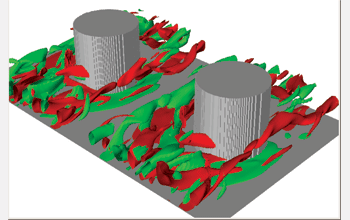Multimedia Gallery
Path of Vorticity
This image shows the path of vorticity through the pin-fin array of a turbine.
The turbine in an aeronautical engine is placed immediately after the combustion chamber. The temperature of the gas after combustion is very high--close to 2000K. An efficient cooling method like pin-fin arrays is necessary to keep the temperature of the turbine low. If the temperature gets too high it causes damage to the turbine and therefore, failure of the engine.
More about this Image
"When Roughness Matters" [Text taken from Teragrid Science Highlights 2008. Taragrid is funded by the National Science Foundation. To learn more, visit the Teragrid website.]
Dimples on golf balls, cholesterol in blood vessels, skyscraper-studded grids of a large city--when there's fluid flow over a rough surface, the flow is affected in ways that are challenging to predict. Because they are dimpled, for example, golf balls fly much farther than would a smooth version of the same ball. It's not intuitively obvious, but the dimples induce turbulence and delay the separation of the "boundary layer" that forms near the ball's surface, thus reducing the drag.
A more telling example of why roughness matters is turbine blades, where surface roughness improves heat transfer and decreases temperature of the turbine, extending the life of the blades. Replacing one blade of a power-generating turbine, says professor of mechanical engineering Stefano Leonardi of the University of Puerto Rico, Mayaquez, "can cost up to a million dollars when considering lost flight time."
Leonardi, who has studied the fluid dynamics of roughness for about 10 years, has used TeraGrid resources at the San Diego Supercomputer Center (SDSC) (BlueGene) and TACC (Lonestar and Ranger) for computational studies of turbulent flow over roughness. He has done the first numerical simulations that apply a powerful method--the "immersed boundary method"--that works efficiently in simulating complex geometry.
"This is an advance in our knowledge of the physics involved," says Leonardi. "Because it allows us to know what's happening very near the wall, where in experiment it's difficult--because you have to insert a probe--to measure the flow effects." His recent results, reported in the Journal of Fluid Mechanics (2008), verify his numerical results with experimental results (by R. A. Antonia, University of Newcastle, Australia, and Paolo Burattini, University of Brussels) for the same flow configuration and provide parameters that quantify roughness.
With Karen Thole of Penn State University, Leonardi is currently working with a turbine manufacturer to quantify how the roughness of aerodynamic features--such as pin fins--on turbine blades affect heat transfer, an important factor in blade durability. "If we can improve the heat transfer of turbine blades we can increase the temperature out of the combustion chamber, thus improving the engine's efficiency, which means less emission and less fuel consumption," says Leonardi. Even relatively small efficiency improvements in these huge power turbines, he points out, have a major impact on cost and environmental concerns.
He explains, "The real problem with roughness and flow is to characterize it, because essentially it's random." Leonardi and his University of Rome collaborator Tito Orlandi found a way to parameterize roughness based on the wall-normal velocity. "In a given rough channel, we identify the geometrical configuration that gives the ideal drag, minimum drag, friction and heat flux."
In a related project, Leonardi and Ian Castro of the University of Southampton are examining how roughness affects atmospherical flow within and over a large-scale cityscape. These applications can help forecast how winds in a city affect flow patterns, which can be important in preparing for terrorist events. With better knowledge of such large-scale fluid dynamics, says Leonardi, it's possible to predict how toxic gas will be transported, which can affect evacuation planning. It is also possible to predict where the pollution generated from an industry is transported. [Research supported by Teragrid grant CTS 07-0005T.] (Date of Image: March 2008)
Credit: Stefano Leonardi, Department of Mechanical Engineering, University of Puerto Rico at Mayaguez
See other images like this on your iPhone or iPad download NSF Science Zone on the Apple App Store.
Images and other media in the National Science Foundation Multimedia Gallery are available for use in print and electronic material by NSF employees, members of the media, university staff, teachers and the general public. All media in the gallery are intended for personal, educational and nonprofit/non-commercial use only.
Images credited to the National Science Foundation, a federal agency, are in the public domain. The images were created by employees of the United States Government as part of their official duties or prepared by contractors as "works for hire" for NSF. You may freely use NSF-credited images and, at your discretion, credit NSF with a "Courtesy: National Science Foundation" notation.
Additional information about general usage can be found in Conditions.
Also Available:
Download the high-resolution JPG version of the image. (1.3 MB)
Use your mouse to right-click (Mac users may need to Ctrl-click) the link above and choose the option that will save the file or target to your computer.

